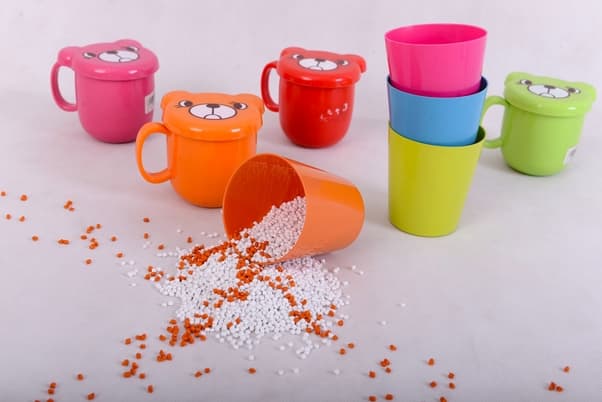Almost all the plastic products consumers use today have a touch of color in them. Color is not there only for aesthetic purposes, they function as a method for different product categories, models, and sizes. Because colored plastic is such a common practice, it leads to an assumption that plastic coloring is a simple process. While in reality, the challenge of coloring polymer involves complex scientific and technical skills.
Read more: What is color masterbatch and how was masterbatch produced?

First and foremost, it is fundamental of developing a polymer colorant package. Often, the color of a product is customized per the producer’s request, from the primary hues to tone, tint and shade. The ratio must be sophisticatedly engineered since the final appearance could be influenced by the polymer structure or the addition of other additives and stabilizers. Furthermore, if the desired color is obtained, there is always a chance other attributes like flame retardants agent, and UV stability will be adversely affected. Hence several items are often put into careful consideration.
1. Chances of Chemical Mismatch
The chemistry of the pigment and the chemistry of the polymers may spot incompatibility problems in the mixing process. The fusion procedure includes elevated temperatures combined with aid from mechanical energy input. As a common fact, chemical reactions are facilitated at such intense thermal conditions. If the chemical formulation is not prepared well beforehand, it cannot be stopped during the mixing procedure and the result will experience a fault or inferiority. Occasionally, errors may happen during the chemical interaction between lesser-known components hidden behind the core material. For instance, cadmium-free red pigments will likely cause problems of flexibility loss when mixing with modified-purposed nylon.
2. The Temperature Environment
The thermal stability of the coloring system also carries a science into its process. Often, each constituent has a distinct level of temperature environment in which it can survive, interact with each other, and be utilized, or all fail together. In order to optimize the formulation, the temperature was elevated to an excess of 150°C (300°F). At this point, the polymer structure is ready to be processed, but the question is whether the colorant chemistry would survive the heat. What engineers need to ensure then is to select the right pigment for the right polymer at the right heat. A pigment mixed with polycarbonate or polysulfone with its high process temperature must have the capability to endure more intense heat. Meanwhile, a pigment chosen for polyethylene or polypropylene can be processed in a relatively cooler thermal environment.
3. Differences Made by the Amount of Colorant
The ratio of pigment added to the base polymer could make a significant impact on how the final products present to be, not only in overall appearance but also in the internal quality of the polymer. An excessive amount of colorant can negatively affect the structure of the base polymer. One of the most noticeable signals is flexibility loss. In scientific terms, the pigment in some cases can be considered a type of nano-constituents. The incorporation of pigment into a polymer can alter its chemical structure, leading to some of its quality being stolen in the process. There is always an acceptable compatibility level in the amount of colorant mixing, usually, a variance of more than 1 -2 % of that amount will cause problems.
4. Different Methods to Color Plastic
There are several manners in which polymers could be colored. They can be manufactured via masterbatch (also called concentrates), in which color pigment is concentrated into a carrier resin prior to injection molding. Other methods include pre-colored resin (or compounds) via melt blending. Each method has its advantages and disadvantages compared to each other. The most cost-effective method is to directly mix pigment powder with plastics. This can only be considered if used in a small quantity or urgent case since the color is not put into optimal condition to truly incorporate with polymer. The result is that the product cannot achieve an ideal color appearance: the color may be faded or unevenly distributed. The second method is using masterbatch, this ranks as the most frequently-used plastic-coloring method. Masterbatch functions as pigments and additives mixed into a frame of polymer resin on high heat. This remains the most economical approach to adding color to plastic in mass, with a quick turnaround time and a high chance to achieve color specification.

Color masterbatch manufactured by EuP[/caption] Cube blend is the method of blending dry masterbatch with natural polymer. When there is no supplied metering equipment, cube blends help engineers control how the exact final output will present. In this method, the polymer does not experience high heat and can preserve its original properties. In such cases with the necessity of a high let-down ratio, engineers often consider the use of pre-colored resin. This method is credited for its ease–of–use and quick performance rate. As pigments are directly polymerized into a resin frame, they can maintain consistency and overall properties and avoid certain errors in the mixture process. Obviously, they do not offer the economical value like masterbatch.
5. The Quality and Weight of Carrier Resin
Lastly, even the quality of the carrier resin has to be taken into consideration. Ensuring the compatibility of the carrier resin and base resin is just the first step, the mismatch in molecular weight between constituents can create a difference. In addition, the base condition can have an influence on the appearance of a color. The same color used in nylon will appear lighter than it will in acrylic, even with the same tone and hue. The external environment after the final products cool down from heat also has a certain percentage of effect on how it will be presented.